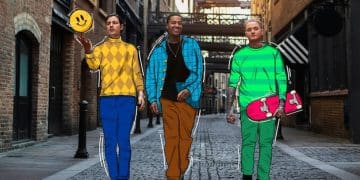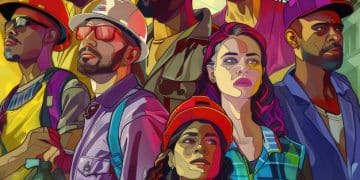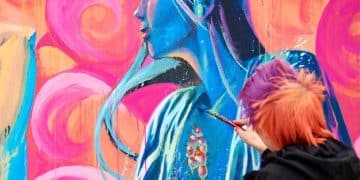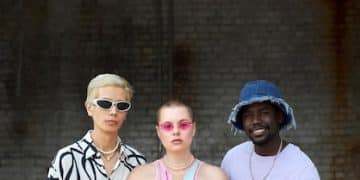Streetwear History: Tracing Urban Style Across 5 Decades
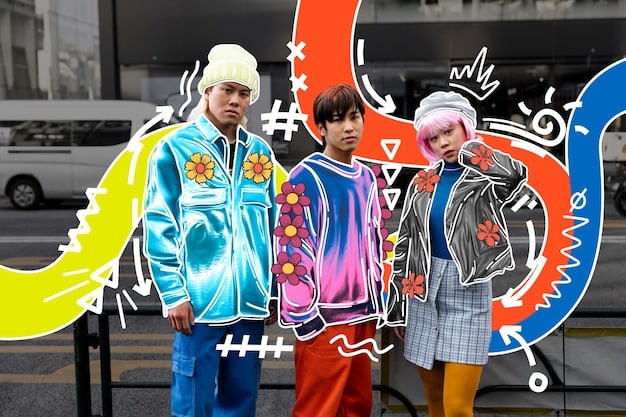
The evolution of streetwear history: tracing the evolution of urban style over 5 decades has transformed from niche subculture into a global fashion phenomenon, deeply influenced by hip-hop, skate, and sports cultures, continuously redefining contemporary sartorial trends.
Ever wondered how hoodies, sneakers, and graphic tees became pillars of global fashion? The journey of streetwear history: tracing the evolution of urban style over 5 decades is a fascinating narrative, intertwining subcultures, music, art, and commerce. This dynamic style, born from the streets, has transcended its origins to influence high fashion runways and mainstream wardrobes.
The Genesis: Laying the Foundations in the 1970s and 1980s
The 1970s and 1980s served as crucibles for what would become modern streetwear. This era saw the emergence of distinct subcultures—skate, surf, and hip-hop—each contributing unique sartorial elements that blended practicality with an underlying rebellious spirit.
Early streetwear wasn’t about curated collections, but about expressing identity through functional clothing. Think about the nascent skate scene in California, where Vans and Stüssy began catering to surfers and skateboarders. These brands offered durable, comfortable attire suitable for active lifestyles, inadvertently laying the groundwork for a burgeoning style.
Skate and Surf Culture: Practicality Meets Style
In Southern California, the burgeoning surf and skate scenes fostered a utilitarian approach to clothing. This wasn’t about high fashion, but about durable clothes that could withstand the wear and tear of concrete and waves. Brands like Vans and Stüssy emerged from this necessity, designing apparel and footwear specifically for these communities.
- 🛹 Sturdy canvas shoes and relaxed silhouettes became staples for skateboarders seeking comfort and grip.
- ☀️ Graphic tees and board shorts epitomized the laid-back, sun-drenched aesthetic of surf culture.
- 🌴 Practicality was key, but individualistic expression through personalized gear quickly followed.
The Hip-Hop Infusion: From Bronx to Global Stage
Simultaneously, on the East Coast, particularly in the Bronx, hip-hop culture was exploding. This movement brought with it a distinct style characterized by oversized tracksuits, gold chains, and branded sneakers. Artists became unintentional fashion trendsetters, their choices influencing millions. Adidas, Puma, and Kangol became synonymous with this emerging urban aesthetic.
The influence wasn’t just aesthetic; it was also economic. Brands recognized the purchasing power of these communities, leading to collaborations and endorsements that further solidified hip-hop’s role in fashion. This period demonstrates how organic adoption by cultural movements can propel styles into the mainstream.
By the end of the 1980s, the distinct threads of skate, surf, and hip-hop had begun to weave together, establishing a powerful, youth-driven force in fashion. This period laid the essential groundwork for streetwear to flourish in the decades to come, moving from subcultural niche to a significant fashion arbiter.
The Golden Age: Streetwear Explodes in the 1990s
The 1990s arguably represent the definitive golden age of streetwear, a period where its fragmented origins coalesced into a recognizable and potent cultural force. This decade saw a significant mainstreaming of urban style, largely propelled by the increasing global reach of hip-hop and the evolving aesthetics of skate culture.
This was an era of bold experimentation, brand loyalty, and the solidification of foundational pieces. Logos became paramount, and the concept of “dropping” limited edition items began to take hold, fostering a nascent sense of exclusivity and hype that remains central to streetwear today.
Skate and Hip-Hop Synergy: A Unified Aesthetic
The lines between skate and hip-hop fashion blurred significantly in the 90s. Baggy jeans, oversized t-shirts, and chunky sneakers became ubiquitous across both scenes. Brands like Supreme, founded in 1994, perfectly captured this intersection, fusing skate utility with a raw, rebellious hip-hop edge. Supreme’s limited releases and distinct red box logo became symbols of cool and exclusivity.
Beyond New York, West Coast influences continued to thrive. Snoop Dogg’s embracing of laid-back Los Angeles style, coupled with the rising popularity of Dr. Dre’s Death Row Records, brought more relaxed fits and localized brand affiliations to the forefront. This regional diversity contributed to the richness of the streetwear landscape.
Rise of Independent Labels and Designer Collaborations
This decade also witnessed the proliferation of independent labels. Brands like FUBU (For Us By Us), Sean John, and Phat Farm emerged, directly catering to the urban demographic. These labels were not just about clothing; they symbolized cultural pride and self-expression.
- 🔗 Independent labels provided an authentic voice, resonating deeply with communities previously underserved by mainstream fashion.
- 🤝 Designer collaborations, though not yet at today’s scale, began to hint at the potential for high-low fashion partnerships.
- 🎵 Musicians increasingly launched their own clothing lines, directly translating their artistic vision into wearable fashion.
The 90s cemented streetwear’s identity as a distinct fashion category, rich in cultural significance and consumer demand. It moved beyond simple subcultural attire to become a global phenomenon, laying vital groundwork for its continued expansion and evolution into the new millennium.
The Millennium Shift: 2000s and the Blurring Lines
The 2000s marked a pivotal transition for streetwear, as it began to shed some of its subcultural exclusivity and embrace a wider, albeit still discerning, audience. This decade was characterized by increased mainstream appeal, the burgeoning influence of Japanese streetwear, and the first significant steps towards cross-over collaborations with high fashion and luxury brands.
As hip-hop gained even greater global dominance, its fashion sensibilities became more refined while retaining their urban edge. The internet also began to play a nascent role, aiding in the dissemination of trends and the formation of online communities dedicated to collecting and discussing limited-edition items.
Japanese Influence: A Bathing Ape and Beyond
Japanese streetwear labels, particularly A Bathing Ape (BAPE), rose to prominence in the 2000s, bringing a fresh, often playful, and highly collectible aesthetic. BAPE’s camouflage patterns, distinctive ape head logo, and celebrity endorsements (most notably by Pharrell Williams) cemented its status as a global streetwear icon.
Other Japanese brands like Neighborhood and Undercover also gained international recognition, known for their meticulous attention to detail, innovative textiles, and unique graphic designs. This infusion of Japanese precision and artistic vision significantly diversified the streetwear landscape, pushing boundaries beyond traditional American urban aesthetics.
Luxury and Celebrity Endorsements: Elevating the Status
The 2000s saw an unprecedented level of celebrity involvement in streetwear. Artists like Kanye West and Pharrell Williams became influential figures, not just for their music but also for their pioneering fashion choices and collaborations. Their endorsements brought streetwear to a broader, more affluent demographic.
- 🌟 Celebrities became key catalysts, showcasing streetwear alongside luxury items and blurring traditional fashion boundaries.
- 💲 The concept of “hype” became more pronounced, with limited edition drops leading to massive queues and secondary market resales.
- 👕 Collaborations between streetwear brands and high-end fashion labels, initially tentative, began to set a precedent for future partnerships.
This period saw streetwear mature, gaining a more sophisticated edge while retaining its rebellious spirit. The 2000s were instrumental in positioning streetwear not just as a passing trend, but as a legitimate and highly influential force within the broader fashion industry, setting the stage for its explosive growth in the subsequent decade.
The Digital Era and Hype Culture: 2010s to Present
The 2010s ushered in a new epoch for streetwear, primarily defined by the explosive growth of social media, the full embrace of “hype” as a marketing strategy, and the unprecedented integration of streetwear with luxury fashion. This decade saw streetwear transition from an influential subculture to a dominant force shaping global sartorial trends.
Online platforms became the primary arenas for brand exposure and product releases, transforming consumption patterns and creating a highly competitive, fast-paced market. The lines between what constituted “streetwear” and “high fashion” became almost indistinguishable, leading to remarkable transformations.
Social Media and the Democratization of Influence
Platforms like Instagram, Tumblr, and later TikTok, became indispensable tools for streetwear brands. They allowed for direct engagement with consumers, facilitated rapid trend dissemination, and enabled micro-influencers to emerge as tastemakers. The visual nature of these platforms was perfectly suited to showcasing new drops and styling options.
The instantaneous feedback loop of social media also fed into the hype cycle, where demand for limited-edition items often far outstripped supply, creating a frenzied environment around releases. This digital acceleration meant that trends could emerge, spread, and evolve at an unprecedented pace.
Luxury Crossovers and Redefining Fashion Norms
Perhaps the most significant development of the 2010s was the complete embracing of streetwear by luxury fashion houses. Collaborations such as Supreme x Louis Vuitton in 2017 shattered traditional boundaries, signaling a new era where street credibility was a coveted asset for heritage brands.
- 💼 Luxury brands adopted streetwear aesthetics, integrating elements like oversized silhouettes, sneakers, and graphic language into their mainline collections.
- 🎨 Designers like Virgil Abloh (Off-White, Louis Vuitton Men’s) and Jerry Lorenzo (Fear of God) became household names, embodying this new collaborative ethos.
- 🌐 This cross-pollination led to streetwear becoming a global phenomenon, appealing to a diverse audience from street enthusiasts to high-end collectors.
The 2010s reshaped the fashion landscape, proving streetwear’s enduring power and adaptability. It solidified its position not just as a trend, but as a foundational element of contemporary fashion, with its impact likely to reverberate for decades to come.
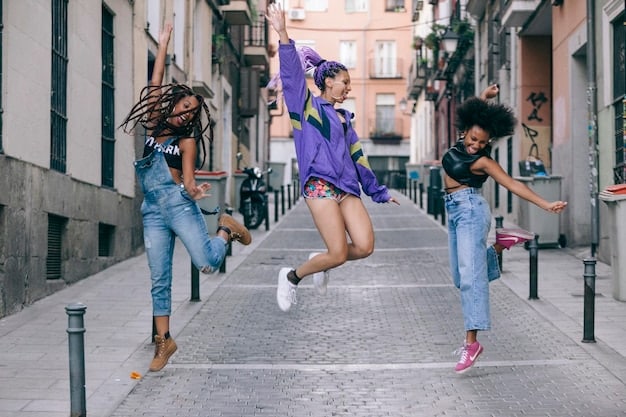
Key Elements and Enduring Icons of Streetwear
While streetwear is constantly evolving, certain core elements and iconic pieces have remained foundational throughout its history. These elements often trace their lineage back to the subcultures that birthed the style, symbolizing authenticity and a connection to its roots.
Understanding these persistent components helps to explain streetwear history: tracing the evolution of urban style over 5 decades. They represent a lexicon of style that, while reinterpreted through different eras, continues to resonate with new generations of enthusiasts.
The Sneaker: Foundation of the Movement
The sneaker is arguably the single most important component of streetwear. From the early Adidas Superstars and Nike Dunks favored by B-boys and skateboarders, to the cult following of Air Jordans and highly sought-after Yeezys, sneakers have always been at the heart of the movement. Their crossover appeal, combining sport, style, and collecting, is unmatched.
The phenomenon of “sneakerheads” – collectors passionate about rare and limited-edition footwear – is a testament to the cultural significance of sneakers within streetwear. Brands continually innovate, releasing new silhouettes and collaborations that fuel this passion.
Graphic Tees and Hoodies: Canvas of Expression
Graphic tees and hoodies serve as the primary canvases for self-expression within streetwear. They are often emblazoned with bold logos, artistic designs, political statements, or brand collaborations. These garments provide an accessible entry point into the culture and allow individuals to broadcast their affiliations and beliefs.
- 🎨 Graphic Tees: Function as wearable art, often featuring unique illustrations, typography, or cultural references.
- 🧥 Hoodies: Provide comfort, anonymity, and a distinct urban silhouette, becoming a versatile staple for layering.
- 💬 Both items allow for immediate visual communication, reflecting the wearer’s identity and connection to specific movements.
Other enduring elements include workwear-inspired garments (like Dickies and Carhartt), caps, and accessories that borrow from sportswear or urban utility. These elements, combined with a discerning eye for fit and brand ethos, form the enduring aesthetic of streetwear, ensuring its continued relevance and appeal across diverse audiences. Understanding these core components is crucial to appreciating the full depth of streetwear’s impact.
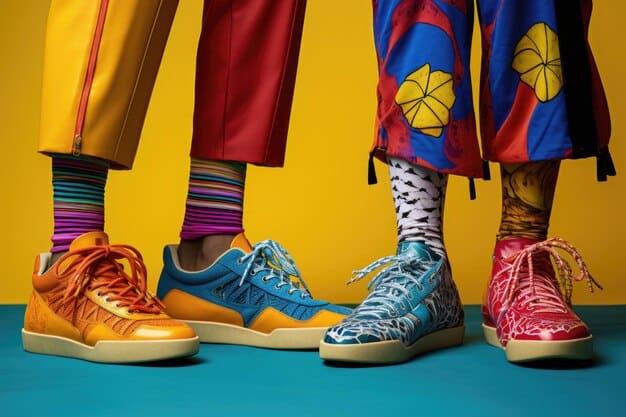
Beyond Trends: Streetwear’s Cultural and Economic Impact
Streetwear’s journey transcends mere fashion trends; it has cemented itself as a powerful cultural and economic force, fundamentally reshaping the industry landscape. Its origins in authenticity and rebellion have allowed it to maintain a unique position that continues to influence consumer behavior and brand strategies.
The ability of streetwear to bridge gaps between diverse communities and inspire new forms of commerce speaks volumes about its enduring legacy. It has not only changed what people wear but also how they interact with fashion and brands.
The Hype Economy and Resale Market
One of the most significant economic impacts of streetwear is the creation of a robust “hype economy” and a thriving secondary resale market. Limited edition drops, fueled by strategic scarcity and strong demand, lead to immediate sell-outs and inflated prices on platforms like StockX and GOAT.
This phenomenon has turned streetwear into an investment for some, attracting a new type of consumer who is also a collector. The resale market alone is a multi-billion dollar industry, demonstrating the intense desire for exclusive items and the power of brand scarcity.
Influence on Mainstream Fashion and Retail
Streetwear has profoundly impacted mainstream fashion and retail. High fashion designers regularly incorporate streetwear aesthetics, and major retailers now prominently feature brands that originated from this movement. It has democratized luxury, making certain elements of high fashion more accessible while elevating the status of urban casual wear.
- 📈 Many traditional fashion houses have launched sub-labels or collaborations aimed specifically at the streetwear market.
- 🛒 Retail environments have adapted, creating more immersive experiences around product drops and fostering community engagement.
- 🔄 The speed of trends has accelerated, with the “see now, buy now” model gaining traction, mirroring streetwear’s fast-paced release cycles.
Culturally, streetwear has fostered a strong sense of community, connecting individuals through shared aesthetics, brand loyalty, and a passion for collecting. It has provided a platform for diverse voices and narratives, often reflecting the social and political currents of the times. This deep cultural resonance ensures that streetwear’s influence will continue to evolve and shape the future of global style for decades to come, far outweighing simple seasonal trends.
The Future Evolution: What’s Next for Urban Style?
As we trace streetwear history: tracing the evolution of urban style over 5 decades, it’s clear that this dynamic segment of fashion is perpetually in motion. The future of urban style will likely be shaped by a confluence of technological advancements, increasing demands for sustainability, and a continuing blend of luxury and casual aesthetics.
Forecasting the exact trajectory is challenging, given streetwear’s inherent adaptability and responsiveness to cultural shifts. However, several key trends are already emerging that suggest where urban style might be headed.
Sustainability and Ethical Production
As environmental consciousness grows, streetwear brands are increasingly expected to adopt more sustainable and ethical production practices. This includes using recycled or repurposed materials, implementing eco-friendly manufacturing processes, and ensuring fair labor conditions.
Consumers, particularly younger generations, are becoming more discerning about the provenance of their clothing. Brands that embrace transparency and demonstrate a commitment to sustainability are likely to gain significant traction, reshaping the industry from within and leading to innovative material use and design philosophies.
Technological Integration and Digital Fashion
The digital realm is poised to play an even larger role in streetwear. This could manifest in several ways:
- 🎮 Digital Fashion: The rise of NFTs, metaverse fashion, and virtual try-on experiences will allow for new forms of self-expression and ownership.
- ⛓️ Blockchain for Authenticity: Technology might be used to verify the authenticity of high-value items, combating counterfeiting in the resale market.
- 🧵 Smart Textiles: Integration of smart fabrics that offer enhanced functionality, comfort, or even interactive elements could become more common.
These technological integrations present opportunities for brands to engage with consumers in novel ways, pushing the boundaries of what fashion can be—both physically and digitally.
Looking ahead, streetwear will likely continue its ascent, becoming even more integrated into the global fashion ecosystem. Its strength lies in its ability to constantly reinvent itself, drawing inspiration from diverse subcultures while retaining its authentic connection to urban life. The emphasis on individuality, community, and the continuous push for innovation will ensure its relevance for many decades to come.
| Key Point | Brief Description |
|---|---|
| 🎤 Subcultural Roots | Born from skate, surf, and hip-hop in the 70s-80s, prioritizing functionality and expression. |
| 🌐 Global Mainstreaming | Exploded in the 90s, influenced by global hip-hop and independent labels. |
| 🤝 Luxury & Tech Fusion | 2000s-Present: Blurring lines with luxury brands, social media, and hype culture. |
| 👟 Enduring Icons | Sneakers, graphic tees, and hoodies form the core aesthetic. |
Frequently Asked Questions About Streetwear History
▼
Streetwear primarily originated from the surf, skate, and hip-hop subcultures in the 1970s and 1980s, particularly in California and New York City. Brands like Stüssy and Supreme, along with early hip-hop artists, shaped its initial aesthetic, emphasizing comfort, functionality, and individual expression. It was a grassroots movement born from youth culture.
▼
Japanese brands significantly influenced streetwear in the 2000s, introducing innovative designs, meticulous craftsmanship, and a focus on limited editions. Labels like A Bathing Ape (BAPE) brought playful graphics and unique branding. Their approach to exclusivity and collectible items deeply impacted the global streetwear market, elevating its artistic and commercial value.
▼
“Hype” culture refers to the phenomenon of high demand and excitement generated around limited edition product releases, often leading to rapid sell-outs. This is fueled by scarcity, brand collaborations, and social media buzz. It creates a secondary resale market where items are sold for significantly higher prices, defining a unique aspect of streetwear commerce.
▼
Streetwear has profoundly influenced high fashion by blurring traditional boundaries. Luxury brands now frequently incorporate streetwear aesthetics, such as oversized silhouettes, hoodies, and sneakers, into their collections. Collaborations between high fashion houses and streetwear labels (e.g., Louis Vuitton x Supreme) have become commonplace, validating streetwear as a legitimate and powerful force in global style.
▼
Sneakers are fundamental to streetwear, evolving from practical athletic footwear to highly coveted fashion items and collector’s pieces. They serve as a core element of personal style, reflecting brand loyalty and cultural affiliations. The “sneakerhead” culture, driven by limited releases and unique designs, underscores their central role in streetwear’s identity and economic model.
Conclusion
The journey of streetwear, from its humble beginnings in distinct urban subcultures to its current status as a global fashion powerhouse, is a testament to its dynamic adaptability and profound cultural relevance. By tracing streetwear history: tracing the evolution of urban style over 5 decades, we observe a continuous dialogue between authenticity, innovation, and commercial appeal. Its enduring impact on mainstream fashion, the creation of unique economic models, and its ability to reflect and shape societal narratives confirm that streetwear is far more than just a trend; it is a foundational pillar of contemporary style that will continue to evolve and inspire for generations to come, consistently pushing boundaries and redefining what fashion can be.

